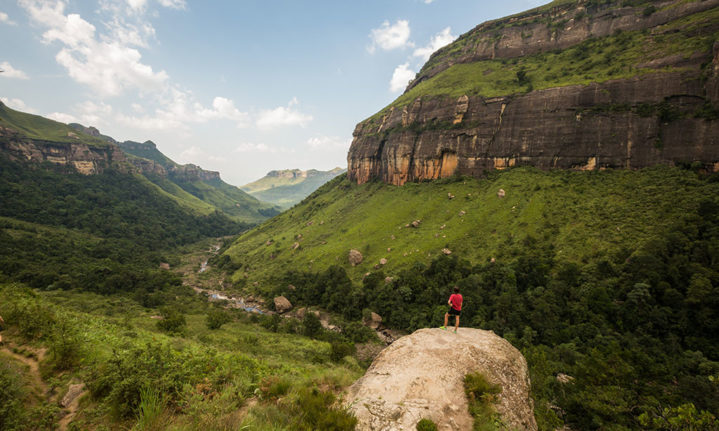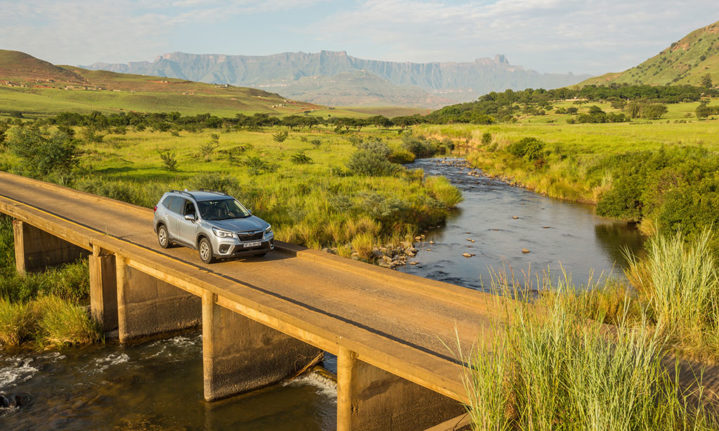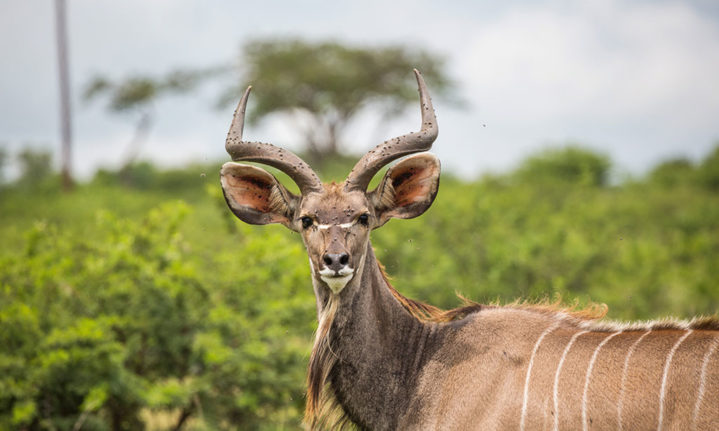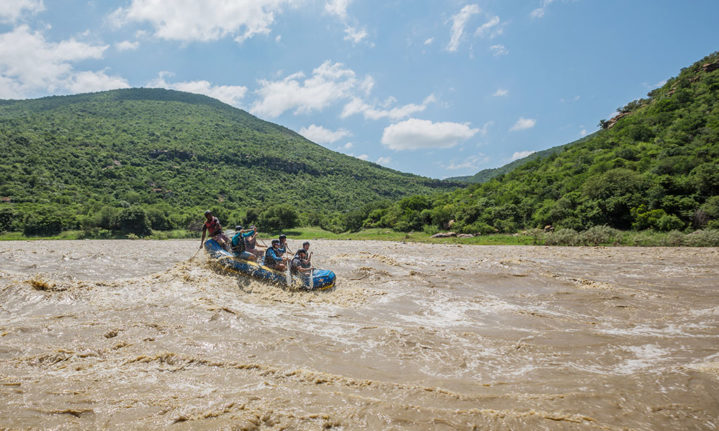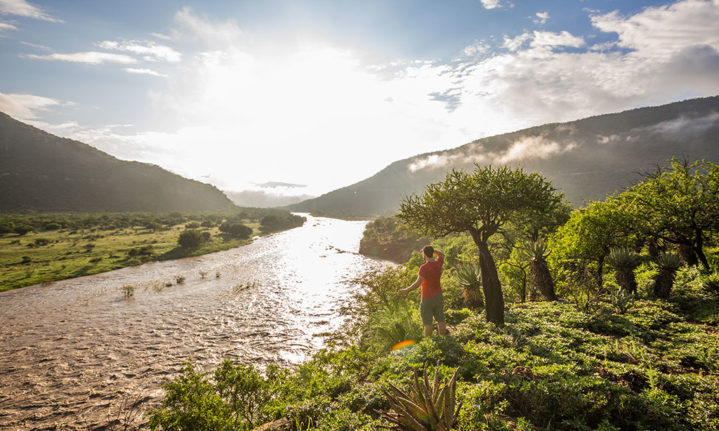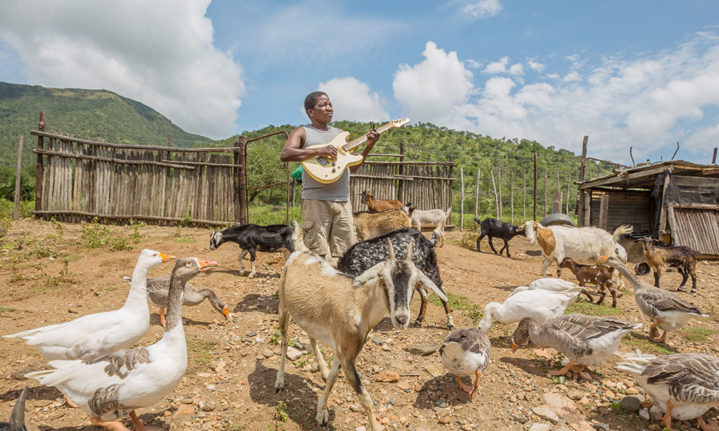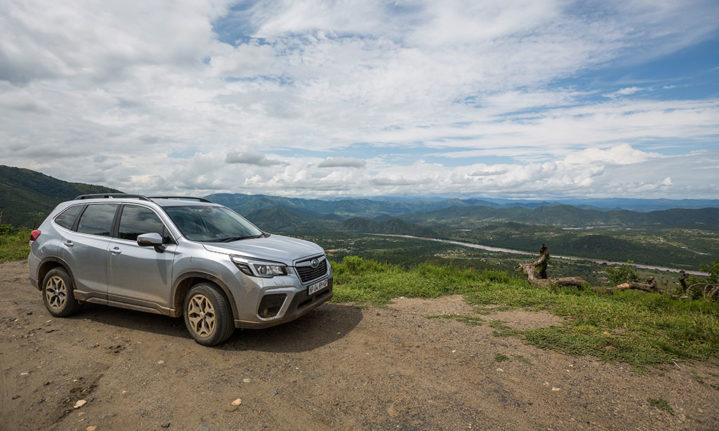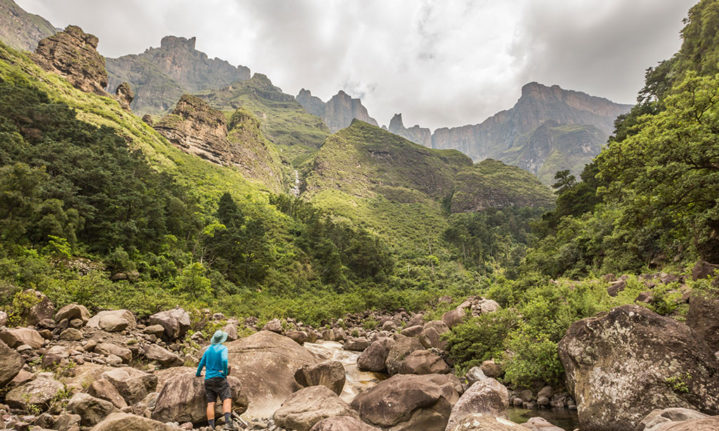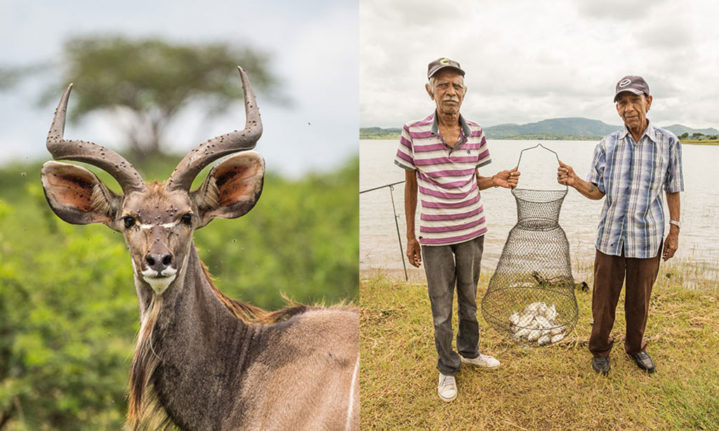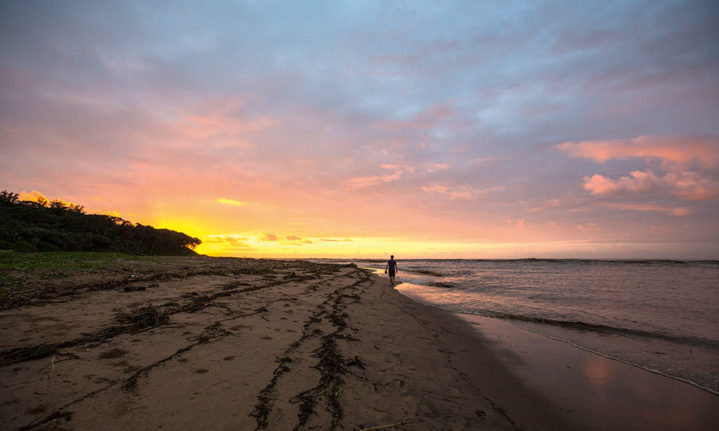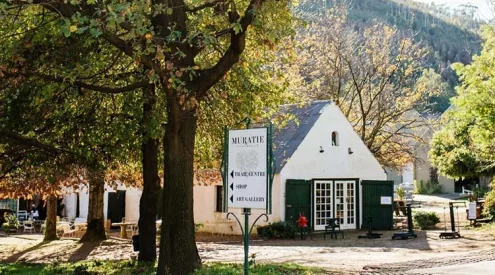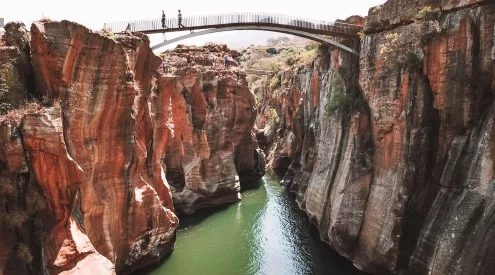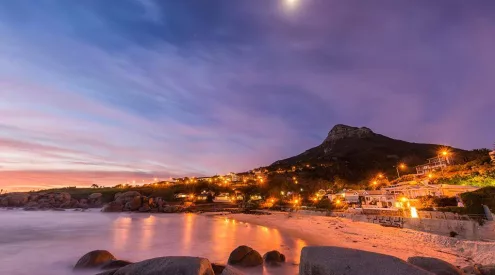I found the source of the Tugela River on the slopes of Mont-aux-Sources on a misty day.
A three-hour hike from the Sentinel car park via the chain ladders brought me to the top of the Drakensberg’s Amphitheatre, where a tiny trickle springs from the Earth.
READ: 10 must-do winter activities in southern Africa
Wild grass covered the narrow, gentle-sloping valley leading to the source. The air smelled of wet earth and animal dung. The heavy clouds absorbed sound and all I could hear was the tinkle of a goat bell on a ridge above me.
I sat down, savouring the stillness and thrill of anticipation for the journey ahead that would take me to the Indian Ocean.
Following the stream down the valley I came upon a herd of donkeys. As I approached, a vicious dog – so big I originally thought it was part of the herd – leapt to its feet. Its barking alerted another dog on the other side of the valley and I found myself caught between the two.
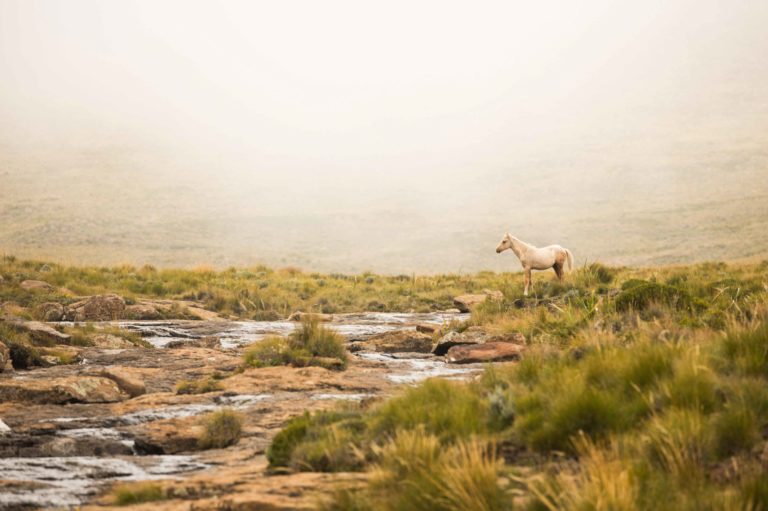
A lone stallion appeared out of the mist, moments before Matthew was harassed by a crazed dog. Image by Matthew Sterne
The protector of the donkeys rushed at me, clearing the stream in a single bound, covering a hundred yards in a blink and skidded to a stop a metre short, spraying saliva and mud in my direction. Two herdsmen in gumboots, blankets and balaclavas appeared out of the mist to subdue the dog and allow me on my way.
It was a fitting way to kick things off.
A bit of background on the Tugela
Forming the border between Zululand and Natal, the Tugela was long considered a frontier, beyond which lay promises of gold and game, of novelty and fortune.
Famous battles were fought, and ultimatums imposed, along its banks. Archaeologists believe that a thousand years ago people on the Tugela were trading with the Arab world. The area is rich in legends of cannibals and hermits and a mountain that swallows people, their cries forever echoing in its caverns.
The river itself is known as the ‘The Startling One’ in Zulu, a name derived from its tendency to rise incredibly quickly, often placing locals in peril. On the right day, it arguably has SA’s best white-water rafting. Those familiar with the Tugela all agree; this is a wild, wild river.
To the source of the river
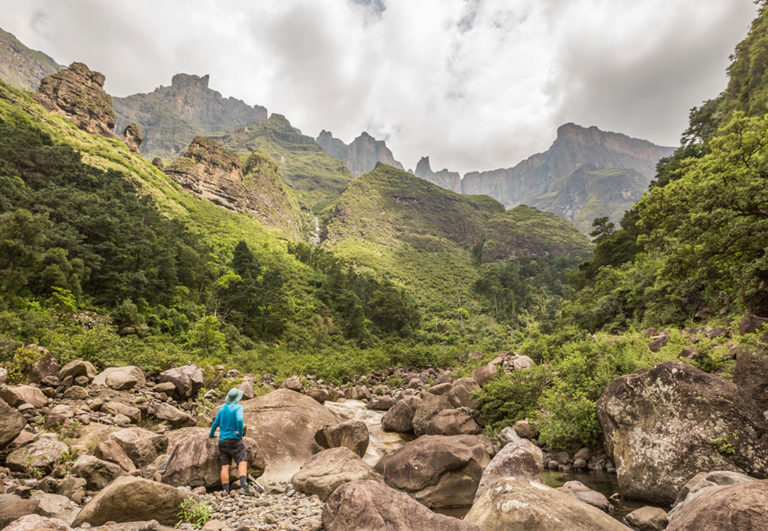
Matthew tries to spot the gorge where the Tugela springs from the top of the Drakensberg’s Amphitheatre before plunging 984 meters into the Royal Natal National Park. Image by Matthew Sterne
The river’s initial meandering course took me to the lip of the Amphitheatre and the top of the world’s second-highest waterfall. At 948 metres, the Tugela Falls is nearly nine times higher than Victoria Falls, although it descends in five distinct stages. Only Angel Falls in Venezuela is taller, by 31 metres.
I peered over the edge, but the waterfall disappeared into clouds, plummeting to a different world far below. From here, the Tugela carves a route through the Midlands before swelling in Zululand and finally meeting the ocean 500 kilometres to the east.
The mist had cleared the next day when I explored the waterfall’s base in the Royal Natal National Park. The Amphitheatre shimmered in an ocean-like haze as I reached the conventional end of the popular Tugela Gorge Hike.
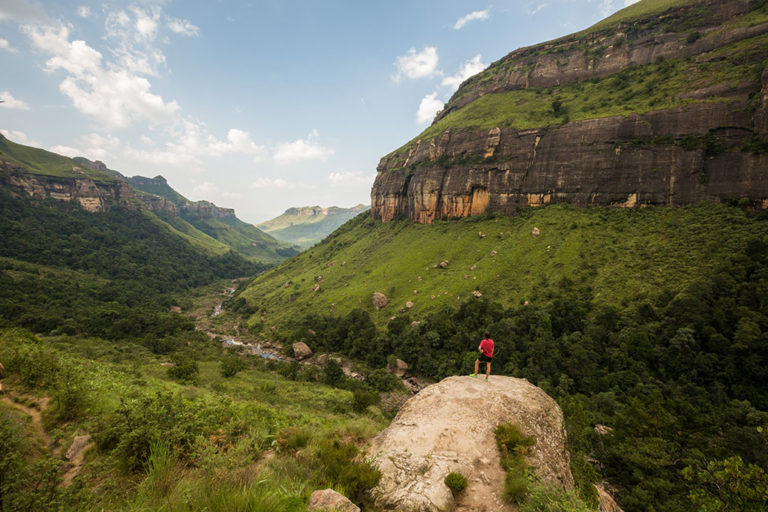
The Tugela Gorge Hike takes half a day and leads to the base of the Berg’s Amphitheatre. Image by Matthew Sterne
The base of the falls, however, is still further on.
I left other hikers resting in the shade and pushed on. The trail disappeared. Cairns guided me as I boulder-hopped my way up the river’s course, disturbing dassies along the way.
The trees grew bigger, the trail steeper.
Eventually, I glimpsed a long, thin trail of water, what I took to be the Tugela’s first of many tributaries. That would have to do as the main falls are almost impossible to see from below unless there’s been heavy rain.
Journeying down the river
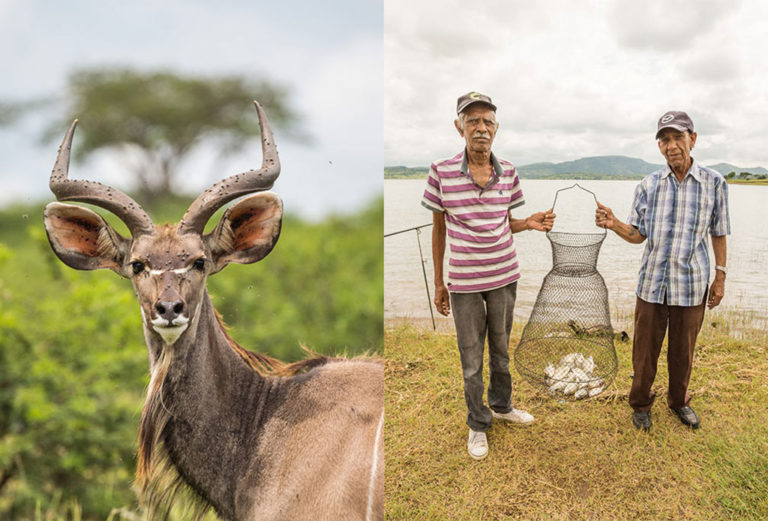
Left: Spioenkop Nature Reserve has plains game and shy kudu; Right: Fishing at Spioenkop Dam is not what it used to be. Images by Matthew Sterne
Leaving Royal Natal, the Tugela’s cIear mountain waters become muddied in the Woodstock Dam, slither through the farmlands around Bergville and enter Spioenkop Dam, an hour’s drive away. The adjoining nature reserve is home to giraffe and zebra and attracts fishermen like Ram Pandoy to its shores.
Visiting from Ladysmith for the day, Ram told me how big the fish used to be here, the classic fisherman’s lament.
‘We also try our luck at Colenso but it’s a bit frightening because of the crocs,’ Ram said. ‘They catch sheep, you know!’
Beyond the dam, we had a good view of Spioenkop, the sight of one of the bloodiest battles in the Anglo-Boer War where three future statesmen were present. Louis Botha led the Boers, Winston Churchill, usually a war correspondent, acted as a courier and Mohandas Gandhi was a stretcher-bearer.
The river continued its journey to the sea and so did I.
Into the Tugela River Valley – in a 4×4
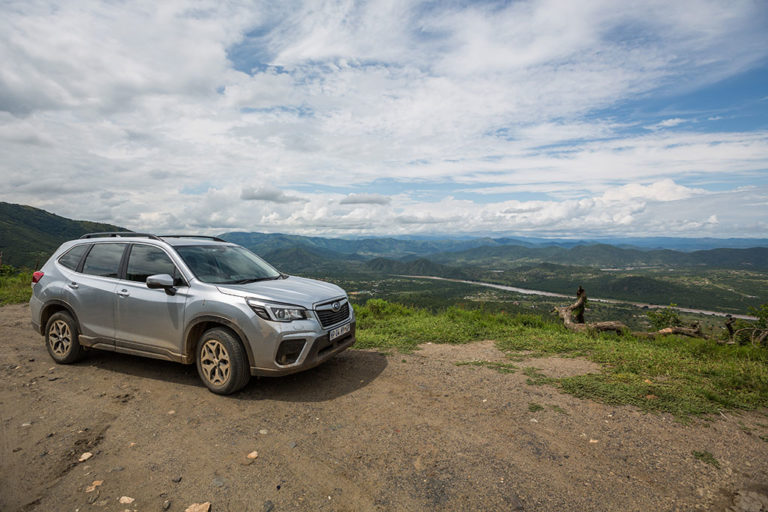
Matthew tackled the 37km to Zingela in a Subaru Forester. Image by Matthew Sterne
Just past Colenso I took an unsigned dirt road into the Tugela River Valley. This was a drier, harsher landscape compared to the fertile fields of the Midlands. Aloes grew in clumps beside the road where scraggly goats stood on their hind legs munching the leaves of squat trees.
Only a 4×4 can handle the 37 kilometres to Zingela Safari & River Company, and many still struggle. The diabolical road is a convenient deterrent to passers-by.
I switched my Subaru Forester to X-Mode, intent to be one of the cars that made it … and reached the lodge an hour later.
This is a remote stretch of the Tugela, with the nearest neighbours 20 kilometres downstream and 50 kilometres upstream. The riverside camp is set among tambotis and Tugela milkwoods in a region of dry valley bushveld.
I arrived at sunset and met Mark Caverleigh who, with a booming voice, pioneer’s spirit and thick white beard, seems like a rogue Santa Claus. That night, while rain pelted down, I chatted to him about the river. He grew up on a tributary of the Tugela and has lived at Zingela, mostly in a tent, since 1983.
‘We have a sense of oneness with the river. It’s how we make our living, with rafting and a lot of fishing. The river provides for us.
Mark also knows the Zambezi well, but thinks the Tugela is more fascinating, more untamed. ‘
‘On multi-day trips, there are times when we paddle for two or three days and don’t see another living soul,’ he tells me with a brandy in hand. ‘Just look where all the battles took place – you’ll see there’s a big chunk where nothing happened because it’s such tough country.’
We looked out into the darkness as a massive bolt of lightning lit up the river.
The rain continued through the night and by morning the river had swollen to twice the size of the day before.
Just perfect for a bachelor’s-party group and me to go rafting.
White-water rafting
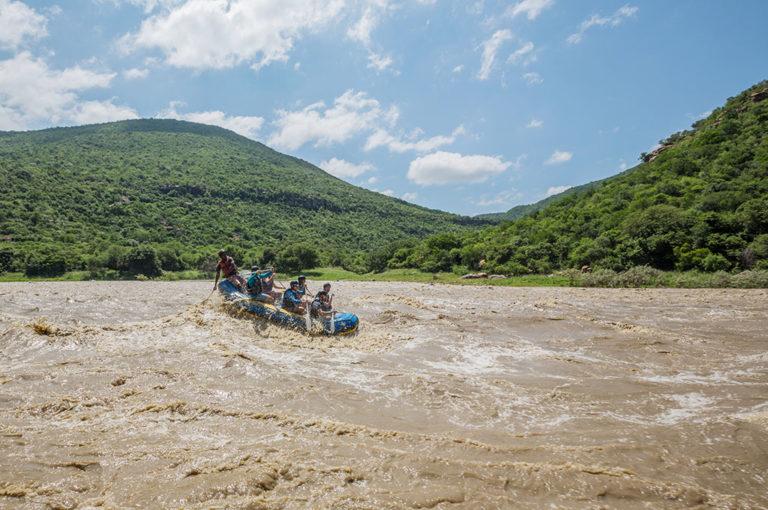
Zingela Camp has hosted the South African white-water rafting championships twice on its stretch of the Tugela. Image by Matthew Sterne
A short drive past shepherd trees and blue-flowered bankrotbos took us to the start, where the river was a churning, swirling, bubbling torrent of mud that looked as though it would suck us under and never release us. It was moving so quickly we wouldn’t need to paddle – but staying in the raft would be a challenge.
The guys took bets on who’d be swimming.
We pushed our seven-man raft out into the marauding river as debris shot past us. A trio of two-man rafts followed.
Our first rapid knocked us airborne and we barely clung on, regrouping in an eddy amid howls of delight. The next rapid claimed its first victims – ironically the only two guys doing the Dusi next year. They’ll probably never live that down. We continued our rollicking ride through the rapids until we finally reached Zingela Camp – wet, exhilarated and ready to go again.
Back roads lead to two new discoveries: Shu Shu Hot Springs and Sipho Mchunu
Back roads led me into the town of Tugela Ferry the next day, encountering a jaywalking leguaan and the occasional hut on the way. Near Greytown, I popped out onto a main road beside neat plantations, which seemed so unnatural after the rugged terrain I had just come from, like a feral child in a school uniform.
I made two discoveries in the clubhouse of St Cathryn’s Golf Estate that night.
The first was Shu Shu Hot Springs.
Near Kranskop, bubbling up in the middle of the Tugela, is a natural anomaly – a hot spring that’s only noticeable and accessible during low water. Glenn and Stienie Buss told me how their families have camped on an island next to the spring every year since 1904.
‘Everything we need for camping is carried across,’ said Stienie. ‘We build pools around the springs, make mud ovens and dig long drops.’
For three weeks they bathe in the hot baths, visit friends at their campsites and have potjiekos competitions.
The second discovery was that Sipho Mchunu lives in the area. Sipho grew up here before going on to form the band Juluka with Johnny Clegg. Piet Nel, the golf-estate owner, gave me the famous musician’s phone number and I arranged to meet him the next day.
Sipho met me outside his kraal, on a rise above the Tugela, and welcomed me in with a smile. We sat on the stoep sipping Windhoek Lagers while goats and ducks pecked next to us.
‘I used to take cattle down to the river every day when I was a boy,’ he said. ‘It was there that I taught myself maskandi music on a guitar made from a Castrol oil can and some fishing line.’
He told me about meeting Johnny in the streets of Joburg, their gigs in the early days and life on the road. However, he always came back to the Tugela.
‘I’ve been everywhere overseas but I prefer it here. This is where I feel free.’
The Place of Bones
I was not far from Jacob Zuma’s Nkandla complex and considered dropping in to ask if Tugela water is used to fill the firepool, but decided to keep moving.
Nearing the ocean I passed the site of the Battle of Ndondakusuka – what many historians consider the bloodiest battle in Zulu history.
It was the culmination of a succession struggle between half-brothers Cetshwayo and Mbuyazi that came to a head on 2 December 1856. The death toll is estimated at 15 000 to 20 000. So many were killed where a tributary meets the Tugela that to this day it’s known as Mathambo, ‘the place of bones’.
The last leg
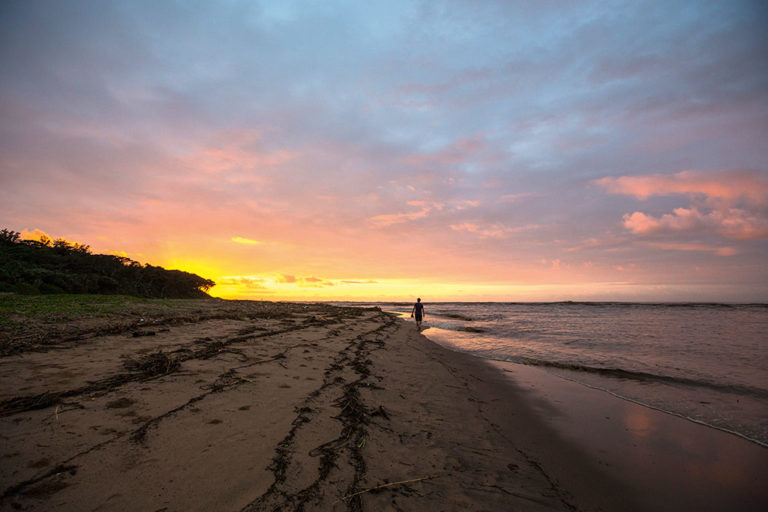
Matthew walked the final hundred metres to where branches, reeds and litter washed up on either side of the river. Image by Matthew Sterne
In the small town of Tugela Mouth the moving mass of a river, 100 metres across, met a fierce sea.
I walked the final hundred metres to where branches, reeds and litter washed up on either side of the river like spittle on a rabid dog’s mouth. It reminded me of the hound that had seen me off so menacingly at the start of my trip. There was something vaguely poetic about the connection.
In fact, my whole experience, all the twists and turns, had been imbued with an air of drama worthy of this storied river. I got lost in the mountain mists and in the gorge, was charged by a dog, destroyed a tyre, tackled rapids, met a musical icon and finally reached the Indian Ocean.
The Tugela might not be South Africa’s longest river – both the Orange and Limpopo are around four times longer – but it best reflects our nation.
Like South Africa, it’s blessed with natural grandeur and extraordinary characters, and has a violent history. It’s spectacular and volatile, dynamic and diverse, tinged with death but full of life.
The name is fitting – this shape-shifting river is, in many ways, pretty darn startling.
Stay Here
Witsieshoek Mountain Lodge is the best place to stay for hiking to the top of the Amphitheatre. It has a quaint feel with a fine restaurant and spectacular views. 058-713-6361, witsieshoek.co.za
The Cavern is a family resort below the Amphitheatre that’s been going since 1941 and offers great meals, guided walks and evening activities. 036-438-6270, cavern.co.za
Zingela River & Safari Company mixes comfort with adventure on one of the wildest stretches of the Tugela. Accommodation ranges from basic tents to luxury rooms built with local materials. 081-816-2541, zingelasafaris.co.za
St Cathryn’s Golf Estate near Greytown has self- catering accommodation on a nine-hole golf course with access to a bass-fishing dam. Home-cooked meals are available on request. 082-555-2661, stcathryns.co.za
Sensayuma Backpackers has views of the Tugela Mouth and private access to the beach. Climb in a hammock or dip in the pool at this laid-back former home. 082-879-2915, sensayuma.co.za
Do this
Hike up to the top of the Tugela Falls from the Sentinel car park. It takes about six hours and includes the famous chain ladders. A 4×4 is recommended to reach the car park; transfers can be arranged from Witsieshoek. 058-713-6361
Hike into Tugela Gorge in the Royal Natal National Park. It’s considered one of the best day trails in the country and boasts fantastic views of the Amphitheatre. 036-438-6310, kznwildlife.com
Visit Spioenkop Nature Reserve for a view of the dam and game such as zebra and giraffe. 036-488-1578, kznwildlife.com
Stop at The Aloes Shop near Colenso to grab a roadside snack. There’s a wide variety of braai meat and biltong on offer too. 082-885-6522
Go white-water rafting from November to April with Zingela River & Safari Company, which has access to a 20-kilometre stretch of rapids and pools. zingelasafaris.co.za
Visit Shu Shu Hot Springs. The campsite only runs for three weeks during the winter school holidays as it’s fairly inaccessible for the rest of the year. 082-577-9404
About the car
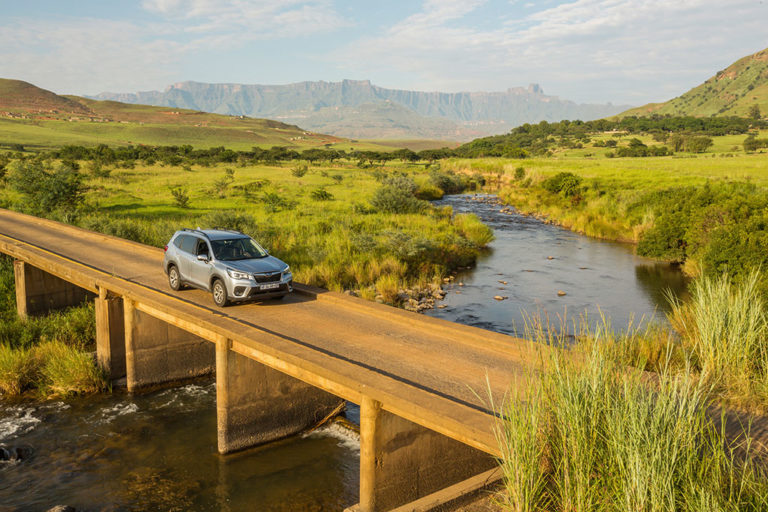
Matthew Sterne adventured in a fifth-generation Forester SUV which handled both highway and back roads with nonchalance. Image by Matthew Sterne
My route was a tale of two drives: the highway from Joburg down to the Tugela, and the back roads that took me along it. I was in the fifth-generation Forester SUV and it handled both with nonchalance.
The adaptive cruise control was fun to use, leaving me to do nothing but steer, and the reverse automatic braking and pre-collision braking also help with ensuring a safe journey. X-Mode is a similar device for off- roading that automatically adjusts the throttle power in difficult driving conditions.
The standard features (such as seven airbags and direct fuel injection) and competitive price ensure good value for money, which has seen this model become one of Subaru’s top sellers.











